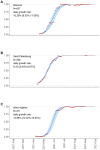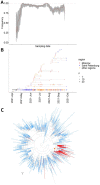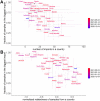This is a preprint.
The rise and spread of the SARS-CoV-2 AY.122 lineage in Russia
- PMID: 34909799
- PMCID: PMC8669866
- DOI: 10.1101/2021.12.02.21267168
The rise and spread of the SARS-CoV-2 AY.122 lineage in Russia
Update in
-
The rise and spread of the SARS-CoV-2 AY.122 lineage in Russia.Virus Evol. 2022 Mar 5;8(1):veac017. doi: 10.1093/ve/veac017. eCollection 2022. Virus Evol. 2022. PMID: 35371558 Free PMC article.
Abstract
Background: Delta has outcompeted most preexisting variants of SARS-CoV-2, becoming the globally predominant lineage by mid-2021. Its subsequent evolution has led to emergence of multiple sublineages, many of which are well-mixed between countries.
Aim: Here, we aim to study the emergence and spread of the Delta lineage in Russia.
Methods: We use a phylogeographic approach to infer imports of Delta sublineages into Russia, and phylodynamic models to assess the rate of their spread.
Results: We show that nearly the entire Delta epidemic in Russia has probably descended from a single import event despite genetic evidence of multiple Delta imports. Indeed, over 90% of Delta samples in Russia are characterized by the nsp2:K81N+ORF7a:P45L pair of mutations which is rare outside Russia, putting them in the AY.122 sublineage. The AY.122 lineage was frequent in Russia among Delta samples from the start, and has not increased in frequency in other countries where it has been observed, suggesting that its high prevalence in Russia has probably resulted from a random founder effect.
Conclusion: The apartness of the genetic composition of the Delta epidemic in Russia makes Russia somewhat unusual, although not exceptional, among other countries.
Figures





References
-
- World Health Organization. Tracking SARS-CoV-2 variants n.d. - PubMed
Publication types
LinkOut - more resources
Full Text Sources
Miscellaneous
